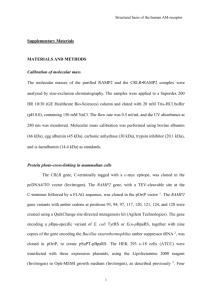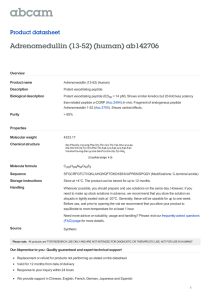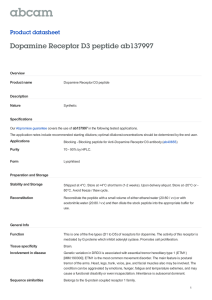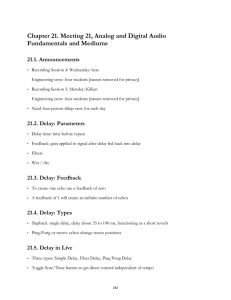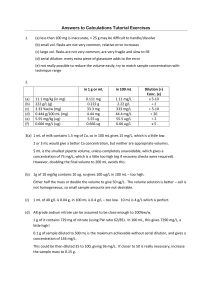CRLR (E-20): sc-389937 - Santa Cruz Biotechnology, Inc.
advertisement
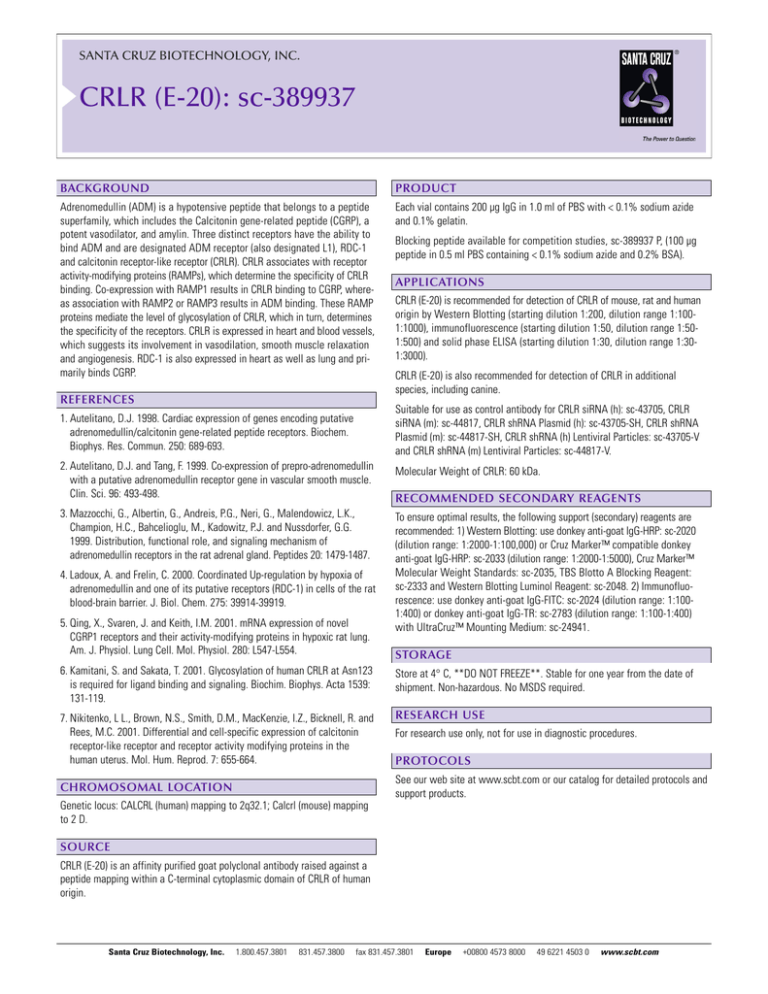
SANTA CRUZ BIOTECHNOLOGY, INC. CRLR (E-20): sc-389937 BACKGROUND PRODUCT Adrenomedullin (ADM) is a hypotensive peptide that belongs to a peptide superfamily, which includes the Calcitonin gene-related peptide (CGRP), a potent vasodilator, and amylin. Three distinct receptors have the ability to bind ADM and are designated ADM receptor (also designated L1), RDC-1 and calcitonin receptor-like receptor (CRLR). CRLR associates with receptor activity-modifying proteins (RAMPs), which determine the specificity of CRLR binding. Co-expression with RAMP1 results in CRLR binding to CGRP, whereas association with RAMP2 or RAMP3 results in ADM binding. These RAMP proteins mediate the level of glycosylation of CRLR, which in turn, determines the specificity of the receptors. CRLR is expressed in heart and blood vessels, which suggests its involvement in vasodilation, smooth muscle relaxation and angiogenesis. RDC-1 is also expressed in heart as well as lung and primarily binds CGRP. Each vial contains 200 µg IgG in 1.0 ml of PBS with < 0.1% sodium azide and 0.1% gelatin. REFERENCES Blocking peptide available for competition studies, sc-389937 P, (100 µg peptide in 0.5 ml PBS containing < 0.1% sodium azide and 0.2% BSA). APPLICATIONS CRLR (E-20) is recommended for detection of CRLR of mouse, rat and human origin by Western Blotting (starting dilution 1:200, dilution range 1:1001:1000), immunofluorescence (starting dilution 1:50, dilution range 1:501:500) and solid phase ELISA (starting dilution 1:30, dilution range 1:301:3000). CRLR (E-20) is also recommended for detection of CRLR in additional species, including canine. Suitable for use as control antibody for CRLR siRNA (h): sc-43705, CRLR siRNA (m): sc-44817, CRLR shRNA Plasmid (h): sc-43705-SH, CRLR shRNA Plasmid (m): sc-44817-SH, CRLR shRNA (h) Lentiviral Particles: sc-43705-V and CRLR shRNA (m) Lentiviral Particles: sc-44817-V. 1. Autelitano, D.J. 1998. Cardiac expression of genes encoding putative adrenomedullin/calcitonin gene-related peptide receptors. Biochem. Biophys. Res. Commun. 250: 689-693. 2. Autelitano, D.J. and Tang, F. 1999. Co-expression of prepro-adrenomedullin with a putative adrenomedullin receptor gene in vascular smooth muscle. Clin. Sci. 96: 493-498. 3. Mazzocchi, G., Albertin, G., Andreis, P.G., Neri, G., Malendowicz, L.K., Champion, H.C., Bahcelioglu, M., Kadowitz, P.J. and Nussdorfer, G.G. 1999. Distribution, functional role, and signaling mechanism of adrenomedullin receptors in the rat adrenal gland. Peptides 20: 1479-1487. 4. Ladoux, A. and Frelin, C. 2000. Coordinated Up-regulation by hypoxia of adrenomedullin and one of its putative receptors (RDC-1) in cells of the rat blood-brain barrier. J. Biol. Chem. 275: 39914-39919. 5. Qing, X., Svaren, J. and Keith, I.M. 2001. mRNA expression of novel CGRP1 receptors and their activity-modifying proteins in hypoxic rat lung. Am. J. Physiol. Lung Cell. Mol. Physiol. 280: L547-L554. Molecular Weight of CRLR: 60 kDa. RECOMMENDED SECONDARY REAGENTS To ensure optimal results, the following support (secondary) reagents are recommended: 1) Western Blotting: use donkey anti-goat IgG-HRP: sc-2020 (dilution range: 1:2000-1:100,000) or Cruz Marker™ compatible donkey anti-goat IgG-HRP: sc-2033 (dilution range: 1:2000-1:5000), Cruz Marker™ Molecular Weight Standards: sc-2035, TBS Blotto A Blocking Reagent: sc-2333 and Western Blotting Luminol Reagent: sc-2048. 2) Immunofluorescence: use donkey anti-goat IgG-FITC: sc-2024 (dilution range: 1:1001:400) or donkey anti-goat IgG-TR: sc-2783 (dilution range: 1:100-1:400) with UltraCruz™ Mounting Medium: sc-24941. STORAGE 6. Kamitani, S. and Sakata, T. 2001. Glycosylation of human CRLR at Asn123 is required for ligand binding and signaling. Biochim. Biophys. Acta 1539: 131-119. Store at 4° C, **DO NOT FREEZE**. Stable for one year from the date of shipment. Non-hazardous. No MSDS required. 7. Nikitenko, L L., Brown, N.S., Smith, D.M., MacKenzie, I.Z., Bicknell, R. and Rees, M.C. 2001. Differential and cell-specific expression of calcitonin receptor-like receptor and receptor activity modifying proteins in the human uterus. Mol. Hum. Reprod. 7: 655-664. RESEARCH USE For research use only, not for use in diagnostic procedures. PROTOCOLS See our web site at www.scbt.com or our catalog for detailed protocols and support products. CHROMOSOMAL LOCATION Genetic locus: CALCRL (human) mapping to 2q32.1; Calcrl (mouse) mapping to 2 D. SOURCE CRLR (E-20) is an affinity purified goat polyclonal antibody raised against a peptide mapping within a C-terminal cytoplasmic domain of CRLR of human origin. Santa Cruz Biotechnology, Inc. 1.800.457.3801 831.457.3800 fax 831.457.3801 Europe +00800 4573 8000 49 6221 4503 0 www.scbt.com
